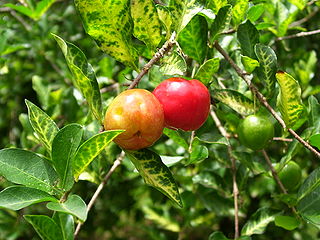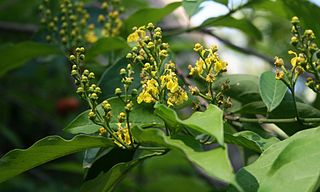
Carica is a genus of flowering plants in the family Caricaceae including C. papaya, the papaya, a widely cultivated fruit tree native to the American tropics.

Cauliflory is a botanical term referring to plants that flower and fruit from their main stems or woody trunks rather than from new growth and shoots. This can allow trees to be pollinated or have their seeds dispersed by animals that climb on trunks and sturdy limbs to feed on the nectar and fruits. With fruit, plants may instead have fruit which drop from the canopy and ripen only after they reach the ground, an alternative "strategy" to cauliflory.

Malpighia is a genus of flowering plants in the nance family, Malpighiaceae. It contains about 45 species of shrubs or small trees, all of which are native to the American tropics. The generic name honours Marcello Malpighi, a 17th-century Italian physician and botanist. The species grow to 1–6 m (3.3–19.7 ft) tall, with a dense, often thorny crown. The leaves are evergreen, simple, 0.5–15 cm (0.20–5.91 in) long, with an entire or serrated margin. The flowers are solitary or in umbels of two to several together, each flower 1–2 cm (0.39–0.79 in) diameter, with five white, pink, red, or purple petals. The fruit is a red, orange, or purple drupe, containing two or three hard seeds. M. emarginata is cultivated for its sweet and juicy fruits, which are very rich in vitamin C.

Montrouziera cauliflora, the giant Houp tree, is a species of flowering plant in the family Clusiaceae. It is found only in New Caledonia, and is one of the largest trees in the rainforests there. It is found in moist evergreen dense forest of low and medium altitude on all types of soil. The tree has a straight trunk, slightly conical, without buttresses but with a slightly wider base, up to 30 m high and 3 m in diameter, with branches protruding horizontally. Houp trees make fruit but it is not edible by humans. Damage causes the bark to exude a yellow resin, thick and sticky, with no peculiar smell. The bark is dark gray or reddish for individuals in very dense forest, with deep vertical cracks. Houp trees are sacred to New Caledonia's indigenous Kanak people, who traditionally used its wood extensively as a building material. It is threatened by habitat loss.

The gracile naked-tailed shrew is a species of mammal in the family Soricidae. It is found in Burundi, Gabon, Kenya, and Uganda. Its natural habitat is swamps.

The Ugandan lowland shrew is a species of mammal in the family Soricidae. It is found in Kenya and Uganda. Its natural habitats are subtropical or tropical swamps and subtropical or tropical moist montane forest. It is threatened by habitat loss.

The Mount Cameroon forest shrew is a species of mammal in the family Soricidae endemic to Cameroon. Its natural habitat is subtropical or tropical moist montane forests.
Allexis cauliflora is a species of plant in the Violaceae family. It is found in Ghana and Nigeria. It is threatened by habitat loss.

Bunchosia is a genus in the Malpighiaceae, a family of about 75 genera of flowering plants in the order Malpighiales. It contains roughly 75 species of trees and shrubs, which are native to dry woodlands, savannas, and wet forests. Their range extends from Mexico and the Caribbean to southeastern Brazil and adjacent Argentina. Bunchosia is one of three arborescent genera of Malpighiaceae with fleshy, bird-dispersed fruits.
Bunchosia hartwegiana is a species of plant in the Malpighiaceae family. It is found in Colombia and Panama.
Bunchosia jamaicensis is a species of plant in the Malpighiaceae family. It is endemic to Jamaica.
Bunchosia tutensis is a species of plant in the Malpighiaceae family. It is endemic to Panama.
Malpighia cauliflora is a species of flowering plant in the family Malpighiaceae, that is endemic to Jamaica. It is threatened by habitat loss.
Saurauia cauliflora is a species of plant in the Actinidiaceae family. It is endemic to Java, Indonesia.
Vatica cauliflora is a species of plant in the family Dipterocarpaceae. It is a tree endemic to Borneo. It is a critically endangered species threatened by habitat loss.

The World's 25 Most Endangered Primates is a list of highly endangered primate species selected and published by the International Union for Conservation of Nature Species Survival Commission Primate Specialist Group, the International Primatological Society (IPS), and Conservation International (CI). The 2012–2014 list added the Bristol Conservation and Science Foundation (BCSF) to the list of publishers. The IUCN/SSC PSG worked with CI to start the list in 2000, but in 2002, during the 19th Congress of the International Primatological Society, primatologists reviewed and debated the list, resulting in the 2002–2004 revision and the endorsement of the IPS. The publication has since been a joint project between the three conservation organizations and has been revised every two years following the biannual Congress of the IPS. Starting with the 2004–2006 report, the title changed to "Primates in Peril: The World's 25 Most Endangered Primates". That same year, the list began to provide information about each species, including their conservation status and the threats they face in the wild. The species text is written in collaboration with experts from the field, with 60 people contributing to the 2006–2008 report and 85 people contributing to the 2008–2010 report. The 2004–2006 and 2006–2008 reports were published in the IUCN/SSC PSG journal Primate Conservation, while the 2008–2010 and 2010-2012 report were published as independent publications by all three contributing organizations.
Oxera baladica is a species of flowering plant in the family Lamiaceae. It comprises two subspecies, both of which are included as vulnerable species on the IUCN Red List:

Bunchosia armeniaca is a species in the family Malpighiaceae native to northwestern South America. Common names include cansaboca, ciruela de fraile, guaimaro, indano and cold-earth mamey.










